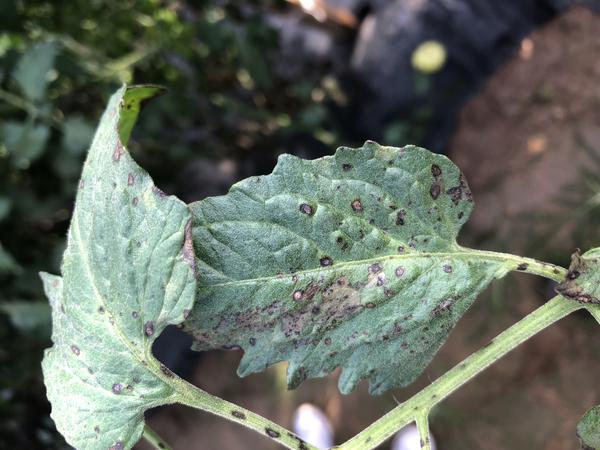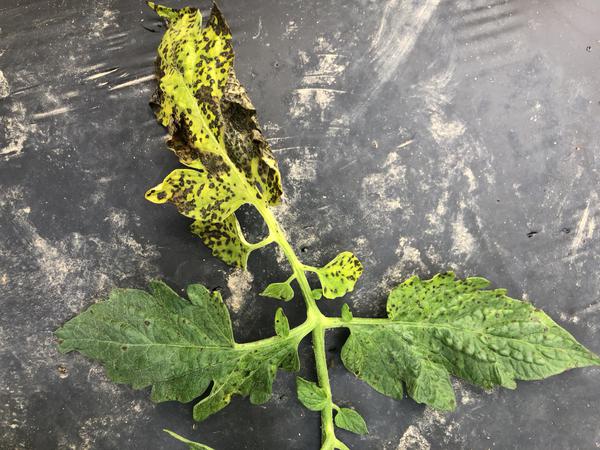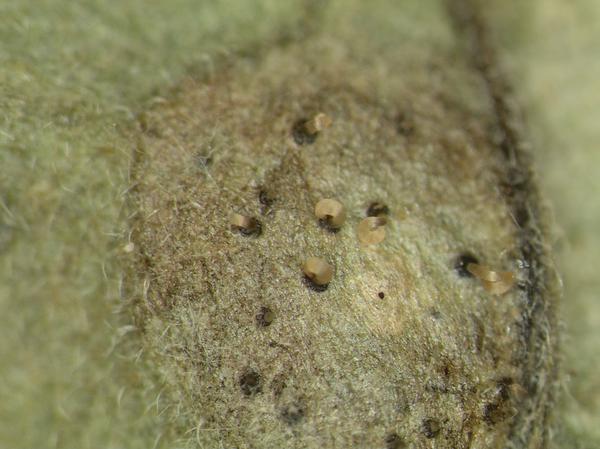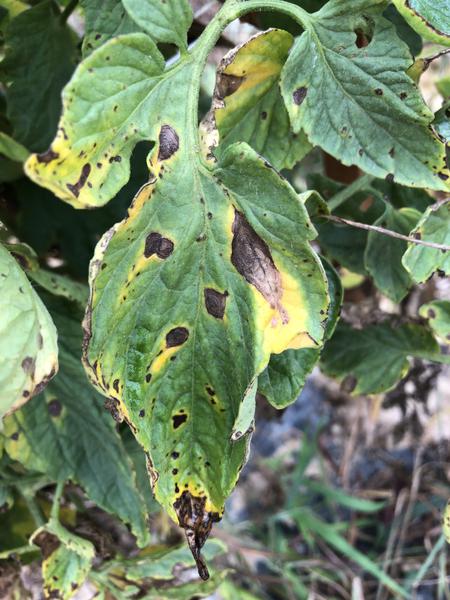Pathogen
Septoria leaf spot is caused by the fungus Septoria lycopersici. The disease is particularly destructive in seasons of moderate temperature and abundant rainfall, with the ability to reduce tomato yields dramatically.
Host Crops and Plants
This disease primarily affects tomato, although some solanaceous weeds like horsenettle (Solanum carolinense L.) are known to be hosts.
Host Parts Affected
Symptoms generally develop on the lower leaves first and then the disease progresses up the plant. Lesions also develop on stems, petioles, and calyx, although fruit are rarely affected.
Identification
Circular, tan to gray, lesions develop on the lower leaves and stems of the plant. Lesions are typically small (<1/8 in), but as lesions become more numerous the entire leaf may become blighted. The lesions generally have a dark-brown perimeter and a yellow halo may develop around the leaf lesions. Small dark spots may appear in the center of the lesion – these are pycnidia, the fruiting body of the fungus where spores are produced. On the underside of the leaves, spots may appear as a darker green color or “water-soaked.” As the disease progresses, traveling from older growth to younger growth, spots may coalesce and the leaves may become entirely blighted. The fruit is rarely infected by this fungus.
Look alike diseases: It can be difficult to distinguish among numerous fungal, foliar leaf spots on tomato. Keep in mind, multiple fungal diseases may be present on a plant making identification even more challenging. Lesions caused by the early blight pathogen will be larger and darker brown than Septoria leaf spots and will have concentric rings. Gray leaf spot, caused by species of Stemphylium, will be very similar to Septoria leaf spots where they are small, circular, with a tan or light brown center, but the center part of the lesion tends to crack open or fall out in gray leaf spot lesions. Most hybrid varieties have resistance to gray leaf spot, but many or most heirloom tomatoes do not have resistance, so it may be difficult to distinguish Septoria leaf spots from gray leaf spot on these varieties.
View this brief video to help you diagnose Septoria leaf spot of tomato!
Favorable Environmental Conditions for Disease
Areas with high humidity and warm temperatures are most susceptible to this disease. The fungus is known to overwinter on infected tomato debris and solanaceous weed hosts (such as horsenettle). Once an area has become infected, spores are generally spread by rain splash. Water is needed to spread the spores and even workers, equipment, or insects travelling through wet foliage infected with Septoria leaf spot can aid in the spreading of the disease.
General Disease Management
- Rotate away from tomato for 2 or more years
- Control presence of horsenettle and other weeds
- Remove crop debris from planting areas (particularly tomato crop debris)
- Reduce the amount of time plants are wet, when possible
- Stake plants to improve air circulation and drying of leaves
- Use mulches or plastic to reduce contact between leaves and soil
- Avoid working in fields when leaves are wet
- Scout plants often and remove infected plants
- Clean tools and equipment after leaving a field
- Use fungicides listed as effective against Septoria leaf spot
Disease Control for Conventional Growers
In addition to the cultural practices listed above, there are several products that are effective at controlling the disease. For the latest fungicide recommendations for Septoria leaf spot, consult the Southeastern US Vegetable Crop Handbook.
Example products for control of Septoria leaf spot in tomato.
| Active Ingredient | Example Product | PHI (days) | FRAC Group |
|---|---|---|---|
| azoxystrobin | Quadris | 0 | 11 |
| chlorothalonil | Bravo | 0 | M |
| chlorothalonil + cymoxanil | Ariston | 3 | M + 27 |
| difenoconazole +cyprodinil | Inspire Super | 0 | 3 + 9 |
| penthiopyrad | Fontelis | 0 | 7 |
| famoxadone + cymoxanil | Tanos | 3 | 11 + 27 |
| fluopyram + trifloxystrobin | Luna Sensation | 3 | 7 + 11 |
| fluxapyroxad + pyraclostrobin | Priaxor | 7 | 7 + 11 |
| fixed copper | Kocide | 0 | M |
| mancozeb | Penncozeb | 5 | M |
| mancozeb + fixed copper | ManKocide | 7 | M + M |
| mancozeb + zoxamide | Gavel | 5 | M + 22 |
| mandipropamid + difenoconazole | Revus Top | 1 | 40 + 3 |
| penthiopyrad | Fontelis | 0 | 7 |
| zinc dimethyldithiocarbamate | Ziram | 7 | M |
Disease Control for Organic Growers
There are limited products available for controlling Septoria leaf spot on tomato. Organic fungicides have limited efficacy, so it is important to implement cultural practices before considering organic fungicides. Some formulations of copper are certified for organic use and may provide adequate control. Be sure to follow directions on the product label.
| Active Ingredient | Example Product |
|---|---|
| fixed copper | (various) |
| potassium bicarbonate | Carb-O-Nator |
Disease Control for Home Gardeners
Home gardeners should first implement the cultural management practices outlined above. Below are some additional practices for home owners.
- Use raised beds and rotate which bed has tomatoes from year to year
- Consider mulching the garden to prevent watersplash from soil to the lower leaves
- If symptoms of Septoria leaf spot appear on the lower leaves, removing affected leaves may reduce disease. But, avoid removing too many leaves.
- For gardens with a history of Septoria leaf spot, fungicides with active ingredients such as chlorothalonil, copper, or mancozeb will help reduce disease, but they must be applied before disease occurs as they can only provide preventative protection. They will not cure the plant.
Additional Resources
- The NC State University Plant Disease and Insect Clinic provides diagnostics and control recommendations
- The Extension Plant Pathology portal provides information on crop disease management
- The Southeastern US Vegetable Crop Handbook provides information on vegetable disease management
- The USDA Fungus-Host Distributions Database provides information about reported hosts for plant pathogenic fungi and oomycetes
Publication date: Dec. 19, 2016
Reviewed/Revised: Sept. 22, 2021
The use of brand names in this publication does not imply endorsement by NC State University or N.C. A&T State University of the products or services named nor discrimination against similar products or services not mentioned.
Recommendations for the use of agricultural chemicals are included in this publication as a convenience to the reader. The use of brand names and any mention or listing of commercial products or services in this publication does not imply endorsement by NC State University or N.C. A&T State University nor discrimination against similar products or services not mentioned. Individuals who use agricultural chemicals are responsible for ensuring that the intended use complies with current regulations and conforms to the product label. Be sure to obtain current information about usage regulations and examine a current product label before applying any chemical. For assistance, contact your local N.C. Cooperative Extension county center.
N.C. Cooperative Extension prohibits discrimination and harassment regardless of age, color, disability, family and marital status, gender identity, national origin, political beliefs, race, religion, sex (including pregnancy), sexual orientation and veteran status.






